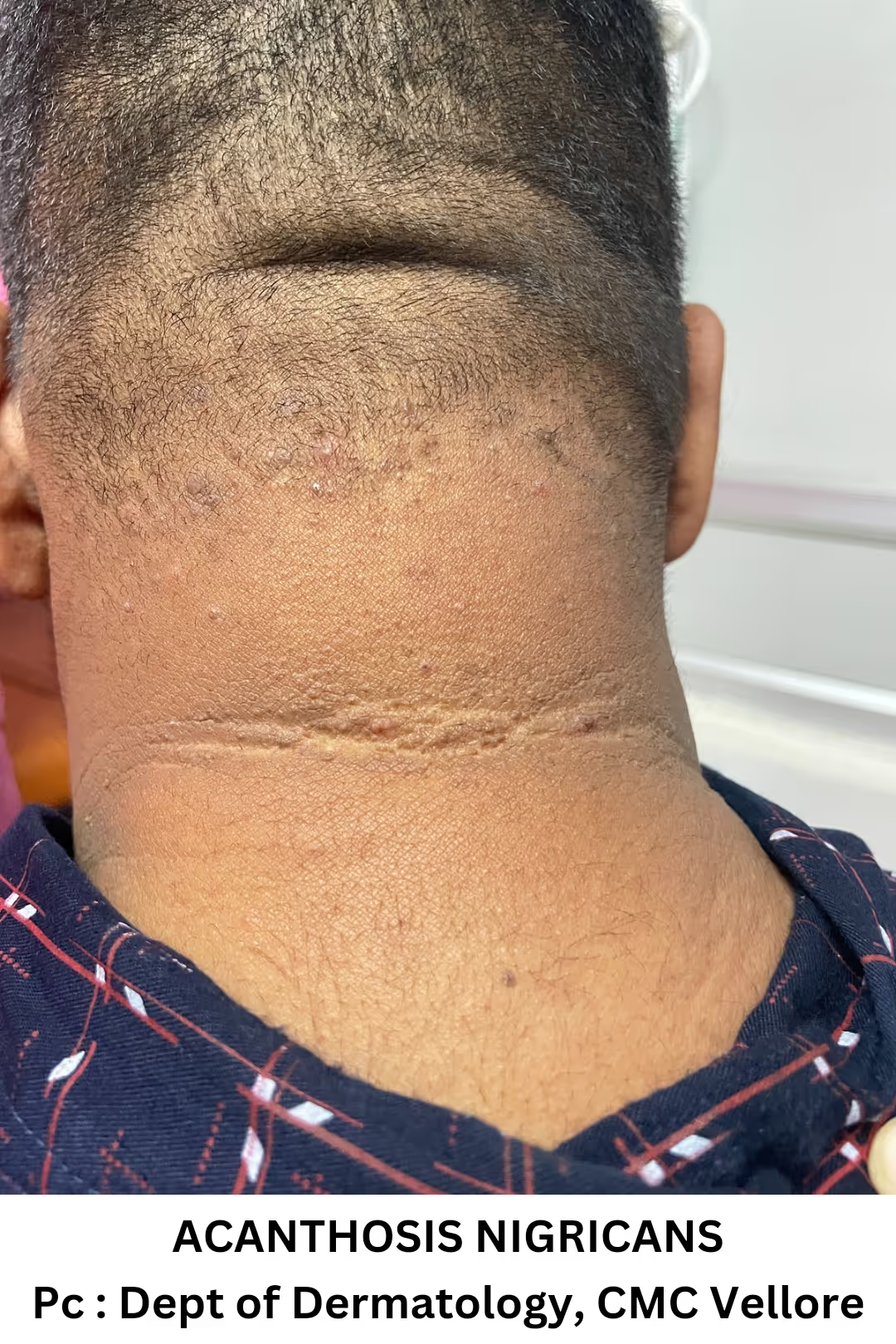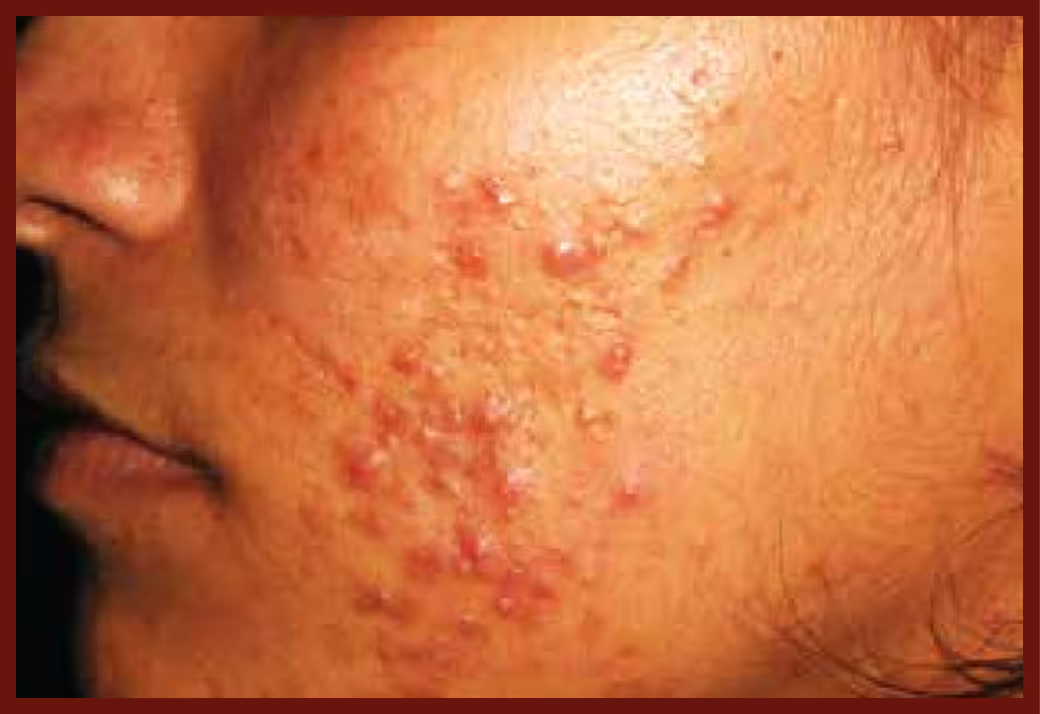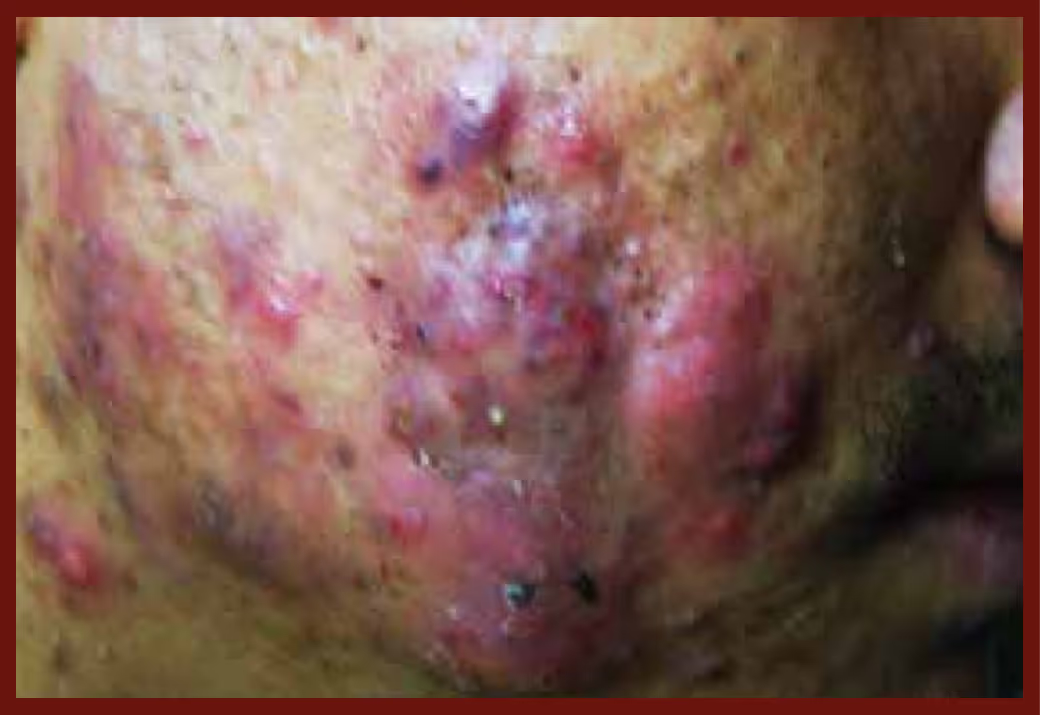Acne (pimples) is an inflammatory skin disease, primarily involving sebaceous glands; affecting the face, but can also occur on the arms, back & chest.
There are 4 key events in causation of Acne:
Excess sebum (oil) in the skin:
The oil producing glands in the skin are stimulated by hormones after puberty to produce more sebum.
Clogged pores (pilosebaceous unit):
The dead cells, bacteria & sebum form a plug at the outlet of the pilosebaceous follicle and appear as black heads (open comedones). If the plug remains below the surface it appears as whiteheads (closed comedones).
Bacteria (P.Acnes):
The bacteria causes inflammation in the pilosebaceous unit. P.Acnes also initiates comedone formation.
Inflammation:
This leads to formation of large solid bumps, pustules & fluid filled cavities called cysts.

Genetic factors: The type and severity of Acne a person gets is influenced by his genes i.e., when a person suffers from severe Acne it is often found that either or both parents have had a similar problem in their childhood.
Pre-menstrual aggravations are commonly seen. Though hormonal factors are implicated, it is the peripheral heightened sensitivity that causes Acne.
Use of cosmetics (oil based), scrubs can aggravate Acne.
A sudden bout of Acne following facials, clean- up, bleaching etc. is common.
Sometimes multiple cysts in the ovaries called polycystic ovarian syndrome can cause Acne in addition to irregular cycles, weight gain, and hair loss on the scalp & excessive hair on the face.
Certain drugs like steroids, anti-tubercular medicines (isoniazid), anti-epileptics (phenobarbitone) can cause Acne like eruptions.
Abuse of topical steroid creams on the face often promoted as fairness creams can cause adverse effects including Acne.
Acne can persist or appear post adolescence. It may be associated with other signs such as hair loss on the scalp & excessive hair on the face.
Diet is an important factor in aggravating Acne. Acne is not caused by specific foods, but certain foods may make some people’s Acne worse. High caloric (glycemic) foods such as pastries and sweets and dairy products like cheese, paneer, butter & ghee can trigger or worsen the existing Acne. Whey protein, used by adults engaged in body-building sports is also implicated in aggravation of Acne. Healthy food habits, fresh vegetables & fruits and lots of water help in maintaining a healthy skin.
Emotional & physical stress an also aggravate Acne.
Dandruff and Acne often co-exist.

Acne usually starts at puberty and mainly affects the teens and young adults. But, Acne can occur at any age. It generally subsides in
mid-twenties.
Sometimes Acne extends beyond twenty five years or may start afresh when it is called adult or late-onset Acne.
Acne can affect both males and females, it tends to be more severe in males.
Acne lesions commonly occur on the face, but can be seen on the arms, chest, back and buttocks.
The skin lesions in Acne include comedones (blackheads and whiteheads), red raised lesions, pus-filled lesion or painful swellings. Based on the predominant type of lesions, the dermatologist grades Acne as mild, moderate or severe.

Acne can be successfully treated at any point of time in the disease timeline, however ,consulting a dermatologist early in the course of disease can also prevent post Acne scarring.
Wash the face 3-4 times daily with preferably soap-free cleansers & water.
The scalp should be cleansed 2-3 times weekly to prevent and remove dandruff.
Acne can affect both males and females, it tends to be more severe in males.
Avoid all greasy cosmetics on the face. Look for a ‘non comedogenic’ cosmetic which is safer in Acne prone skin.
Do not squeeze or pick the pimples. It can cause scarring.
Wash the face 3-4 times daily with preferably soap-free cleansers & water.
The scalp should be cleansed 2-3 times weekly to prevent and remove dandruff.
Acne can affect both males and females, it tends to be more severe in males.
Avoid all greasy cosmetics on the face. Look for a ‘non comedogenic’ cosmetic which is safer in Acne prone skin.
Do not squeeze or pick the pimples. It can cause scarring.
The medications include topical medications (applied to the skin) or systemic (which is taken internally).
Topical treatment includes benzoyl peroxide, retinoids, azelaic acid, antibiotic creams (clindamycin), etc. Topical treatments can cause initial irritation or dryness or aggravation of Acne. Hence these should be cautiously used and continued as per the dermatologists’ recommendations.
Systemic treatment includes Antibiotics-azithromycin, doxycycline, minocycline & tetracyclines, Retinoids-isotretinoin. Hormonal therapy-oral contraceptive pills, anti-androgens. Most patients may require a combination of both therapies.
Some patients may also require chemical peel, laser and other technologies for faster and effective treatment.
Your Dermatologist will decide & advise you on the appropriate medications after assessing your condition.
It is always better to prevent scars by early & proper treatment of severe Acne.
Chemical peels such as glycolic acid & salicylic acid peels may be helpful for your marks.
Dermatologists treat the scars by various methods such as microderm- abrasion, derma roller, laser (fractional lasers) and subcision.
Keloidal scars may need intralesional injections or cryotherapy.
Acne can clear completely, however it can recur at times. Any of the aggravating factors such as hormonal triggers, cosmetic use, emotional stress, topical steroid application, systemic medicines, dietary factors may play a role in the recurrence.
Acne may resolve or subside over time. However, it may not clear on its own and may produce pus- filled lesions and large swellings which may leave permanent disfiguring scars, if left untreated.
Acne often causes poor self-image, depression & anxiety to the person afflicted by the condition.
The therapy recommendations and counseling by your dermatologist will help in easing the physical and psychological scarring caused by the disease.

Sequence of events in Acne - Illustrative representation
Disclaimer: This article is only for general patient information and is not intended for self medication. There is no legal liability of IADVL arising out of any adverse consequence to the patient. Subsequent to its use for self treatment of the disease images adjust for the depiction of the condition and is not to be used for any other purpose.
Explore articles in this section to gain a deeper understanding of various skin diseases and conditions. Each article provides detailed information on symptoms, causes, and treatment options, helping you to manage and address these dermatological issues effectively.

Psoriasis is a skin condition where new skin forms at a faster rate, showing up as red rashes with whitish scales, commonly over elbows, knees, and other body parts.

Dandruff is a common scalp condition in which small pieces of dry skin flake off from the scalp and is usually associated with itching. The exact cause of Dandruff and Seborrhoeic Dermatitis is unknown.

Dermatophyte infection is a superficial fungal infection of skin, hair and nails. It is also known as ringworm. In Hindi it is termed as Daad and in Marathi it is termed as Gachkaran.